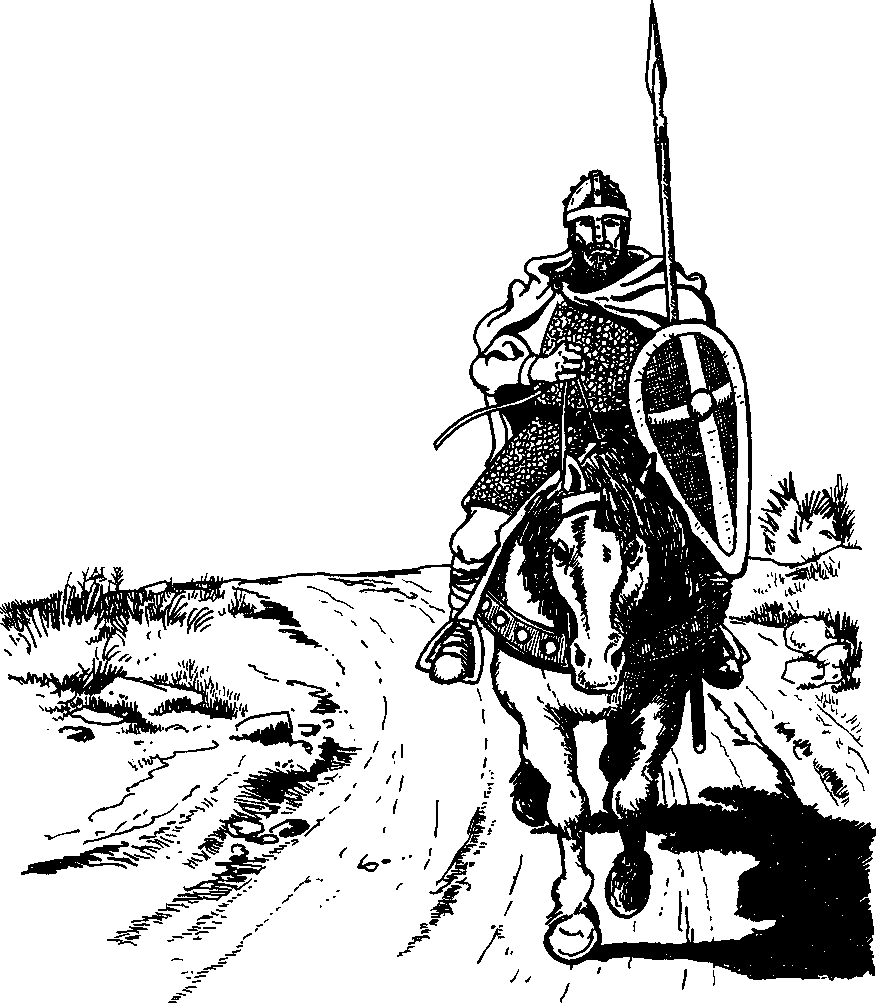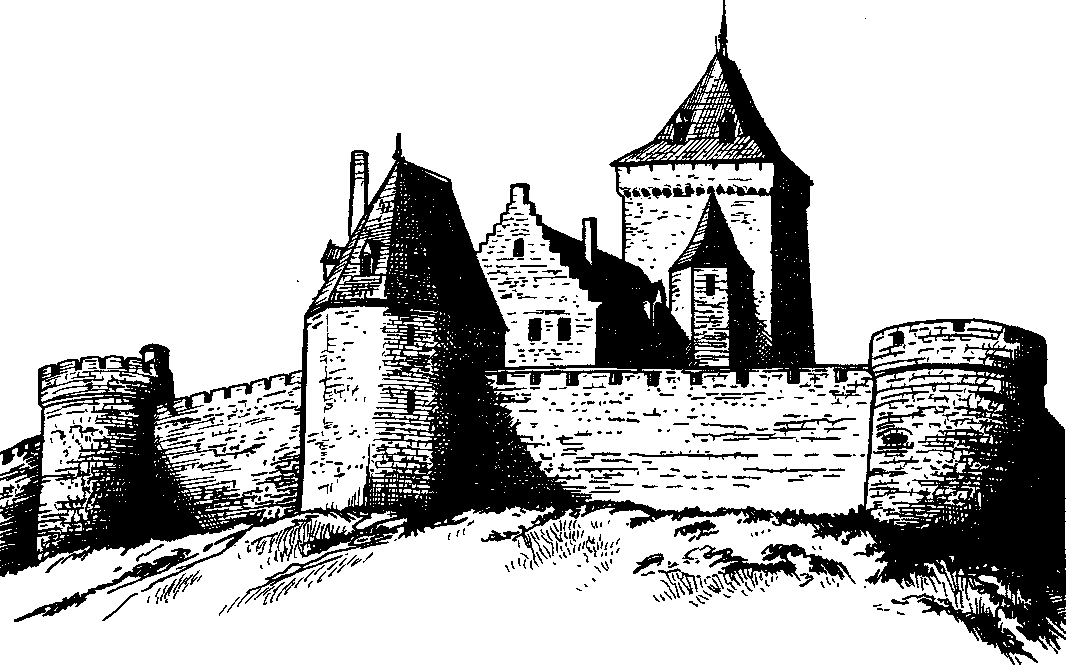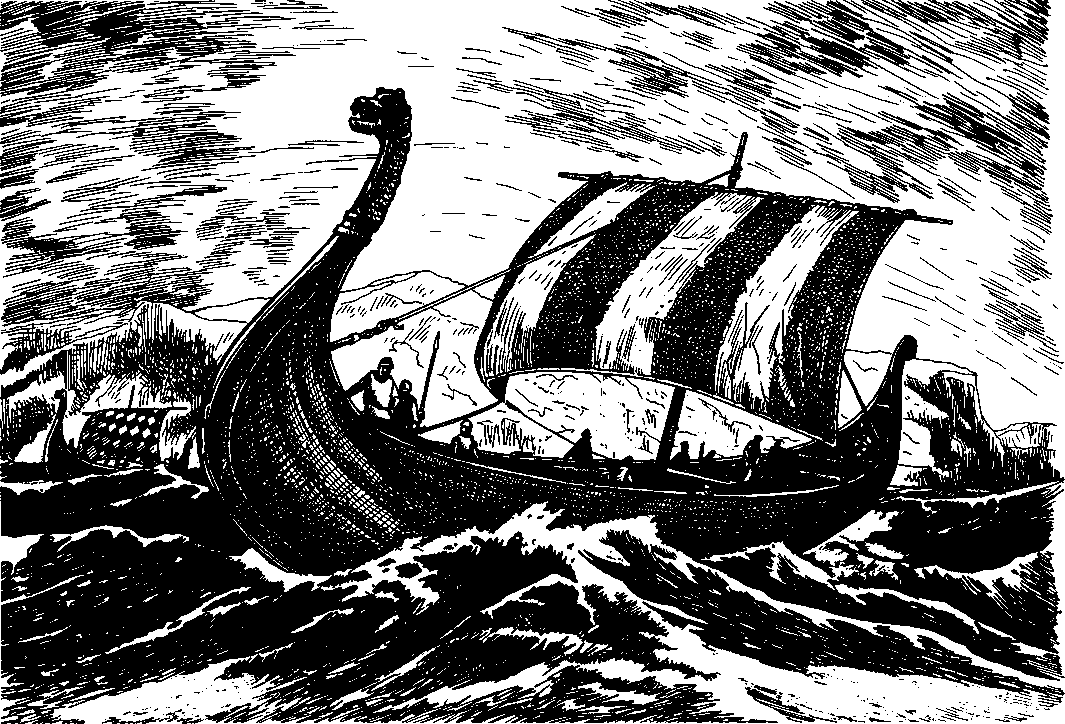The Vikings or Norsemen, Germanic inhabitants of Scandinavia (Denmark, Sweden and Norway), were remarkable ship builders and audacious seamen. During the 7th century, for quite unknown reasons (over-population, lack of land, banishment of nobles, simple lust for pillage?), they began expansion and conquest. Hardy adventurers, they undertook long and perilous sea travels in the Baltic sea, opening commercial routes in the Russian rivers up to the Black sea and even to the Near East. In a western direction they explored and settled in Iceland and Greenland. They probably discovered America five hundred years before Christopher Columbus by exploring the coasts of Labrador and Newfoundland.
In the 9th century they sailed south and conquered the northern part of the British Isles. They came with the intention of trading, but having been badly received, they turned to pillaging and launched bloody raids on the Atlantic coasts. Their long, swift, high-prowed ships could penetrate deep in the hinterland to ascend rivers, from which they launched mobile surprise raids. Before long they seized horses and rode inland, ravaging the countryside.
As early as 809, the prosperous port of Dorestad in the Netherlands was attacked. Chronicles mention Viking aggressions in Rouen in 841 and Nantes in 844. Spain was raided in 844, Bordeaux was besieged in 848, Paris was a target in 845, 856 and 861. The Norsemen passed the Strait of Gibraltar in 859 and spread murder and devastation on the Mediterranean coasts in Spain, southern France and Italy. They sailed the Rhine in 885 and looted Nimegue, Cologne and Bonn. In 886, a huge fleet of Viking ships ransomed Paris and looted the rich provinces of Champagne and Burgundy.
According to chronicles, everywhere they came, the Vikings murdered people and ransomed, looted and burned villages, cities and even churches, monasteries and abbeys—all because they were unscrupulous and devilish pagans who had never known the edifying influences of Roman civilization. But were they really that bad? Were they exclusively responsible for all crimes, thefts, murders and pillages of the time?
Actually, whenever and wherever they were given the opportunity, the Vikings appear to have been rather peaceful merchants, peasants and good administrators. Progressively the Norsemen converted from vagabond looters to sedentary settlers. By the treaty of Saint-Clair-sur-Epte in 911, the Carolingian king of France, Charles the Simple (893-922), yielded the Viking chief, Rollo, a vast territory in the region of Rouen. With astonishing rapidity, the Norsemen (called henceforth Norman) became Christian, learned the French language, mixed with

Carolingian horseman. The Carolingian time saw the beginning of the supremacy of the cavalry on the battlefield. The warrior on horseback benefited from several important technical improvements invented by the Franks. The horseshoe increased the animal’s capacity, and speed and mastery over the horse were increased with the use of spurs attached to the rider’s feet. A well-designed saddle and stirrups introduced in the 8th century provided more stability, enabling the horseman to use his spear both as a throwing and a shock weapon. Armament consisted of a lance, a long right sword and a battle-ax. Defensive equipment was composed of a long wooden pointed shield reinforced with iron bars, and—for the richest—a metal helmet with nose piece and a coat of mail made of metal rings called a hauberk.

Castle Valkhof in Nimegue (Netherlands). Nimegue (Nijmegen in Dutch) was situated in the province of Gelderland. The city was the capital of the Batave tribey then a Roman castrum called Noviomagus Batavorum on the Rhine limes. Nimegue was one of Charlemagne’s residences, and the emperor had a castle built called Valkhof. The castle and the city were ravaged by the Norsemen in 880. The German emperor Friedrich Barbarossa ordered the reconstruction of the Valkhof in 1155; the castle served as residence for the dukes of Gelderland throughout the Middle Ages. The Valkhof was destroyed by the French in 1796.
The local populations and assimilated manners and customs.
From the region of Caen, the Normans conquered the valley of the Orne River about 933, the Cotentin Peninsula and the British Channel Islands in 1051. The Norman territories became the rich duchy of Normandy. In the 11th century, the Normans settled down in Britain, Sicily and southern Italy.
Norman fortification was characterized by the use of earth entrenchments and wooden palisades. Villages were often circular, in a form called ringfort, but there was also a vast entrenched camp called Hague-Dike, a four kilometer-long earth rampart erected in the 10th century to defend the Hague peninsula in the Cotentin (Normandy). Norman fortifications, notably the motte-and-bailey castle (see chapter 2), played an important role in early feudal times.
During the 8th and 9th century, the Vikings were not the only invaders to ravage Europe, and other looters contributed to the general insecurity. In the Mediterranean sea, the French and Italian coasts were exposed to Spanish corsairs, Berber pirates, and Muslim raiders whose razzias were, in many respects, similar to those of the Norsemen: sea robbers turning into mounted marauders on land. In eastern Europe, the Magyards, coming from central Asia, brought troubles and insecurity in Germany and even pushed deadly incursions up into Burgundy, Provence, and northern Italy. For a century, the savagery of their raids once again brought Asiatic danger to the European lands. In 955, however, the Mag-





 World History
World History









